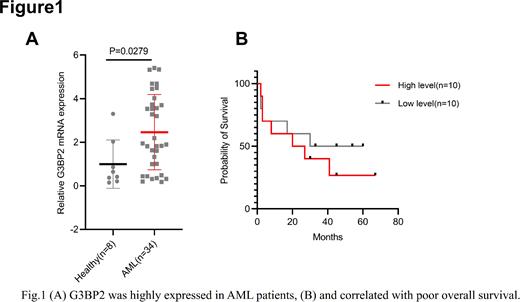Abstract
Background: Identifying the molecular alterations that drive acute myeloid leukemia (AML) progression is critical for developing effective therapies. Currently, the B-cell lymphoma-2 (BCL2) selective inhibitor venetoclax revealed puissant survival benefits in the naive and refractory/relapse (R/R) acute myeloid leukemia (AML) patients during combination therapy. However, there are complex factors that limit the therapeutic efficacy of using venetoclax. Our study aimed to unravel the role and regulatory mechanisms of Ras-GTPase-activating protein SH3-domainbinding protein 2 (G3BP2) in AML, and to explore its potential interaction with venetoclax.
Method: The mRNA levels of G3BP2 were detected in patients with AML and healthy donors using quantitative reverse transcription-PCR (RT-qPCR). Functional assays were performed to examine the effects of G3BP2 on cell proliferation and apoptosis in vitro. Gene set enrichment analysis (GSEA) was carried out to explore aberrantly activated pathways as G3BP2 increased. A Pearson correlation test was conducted to identify a correlation between G3BP2 and anti-apoptotic BCL-2 family proteins (BCL-2 and MCL-1). A small molecule (C108) that interfered with G3BP2 was used in combination with venetoclax to assess whether it yielded synergistic effects. We applied bioinformatics analysis, JASPAR database, western blot analysis, and actinomycin D-dependent mRNA stability assay to identify the transcription factor for MLC1.
Results: G3BP2 was upregulated in AML patients, and its expression was negatively correlated with overall survival (OS). Knockdown of G3BP2 significantly inhibited cell proliferation and enhanced apoptosis in vitro. GSEA revealed the mTOR signaling was activated when G3BP2 was upregulated, and knockdown of G3BP2 abrogated the redundancy of pmTOR and pS6. Targeting G3BP2 with C108 synergized with venetoclax to induce apoptosis in primary AML cells and cell lines. Mechanistically, down-regulated G3BP2 led to increased ELF1 mRNA decay, thus impacting the decreased expression of MCL1 to overcome the inadequate venetoclax activity in AML cells.
Conclusion: Our findings demonstrated that elevated G3BP2 might be responsible for the progress of AML. Moreover, G3BP2 could promote MCL1 transcription via ELF1, thus resulting in poor response to venetoclax in AML cells. These results provided a potential therapeutic target for venetoclax combination therapy.
Keywords: Acute myeloid leukemia, G3BP2, Venetoclax, MCL1, ELF1
Disclosures
No relevant conflicts of interest to declare.
Author notes
Asterisk with author names denotes non-ASH members.


This feature is available to Subscribers Only
Sign In or Create an Account Close Modal